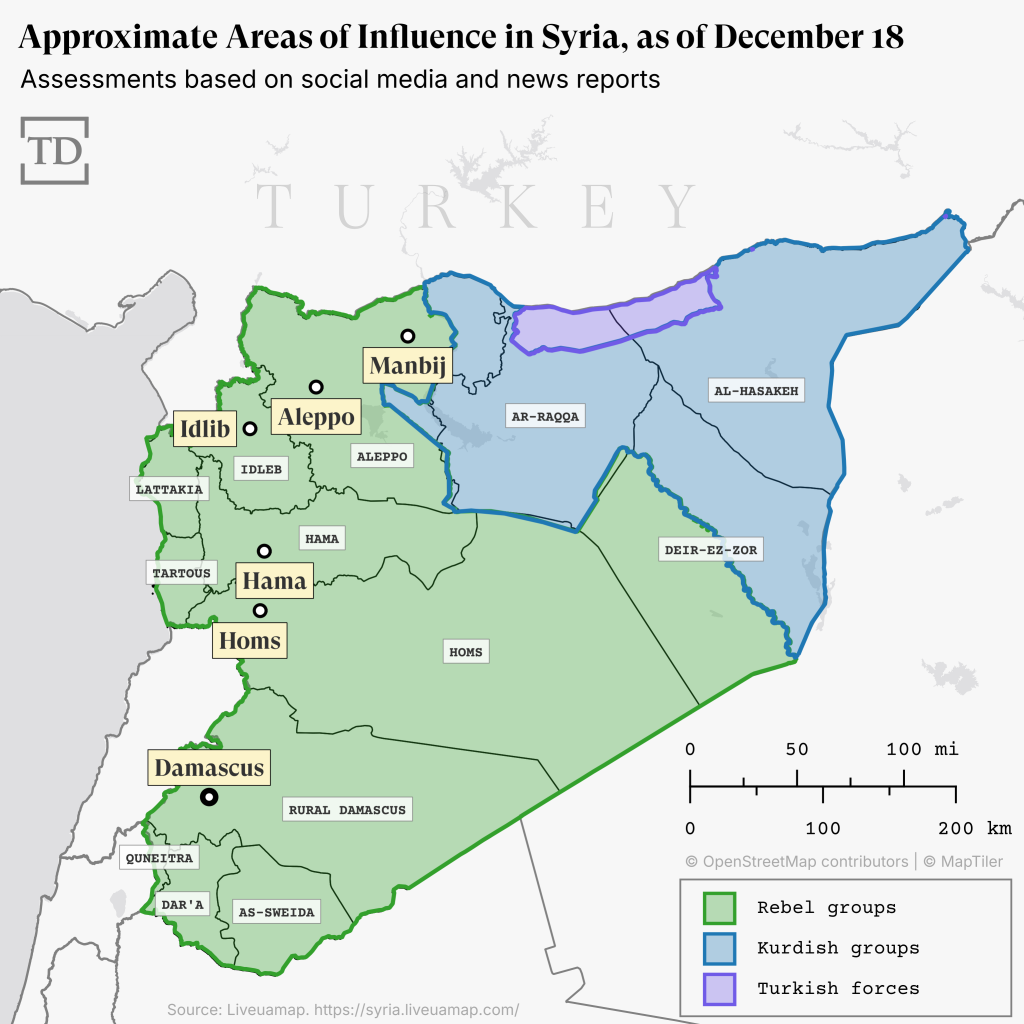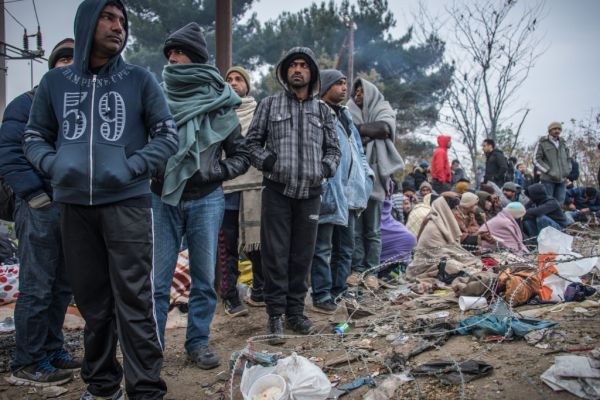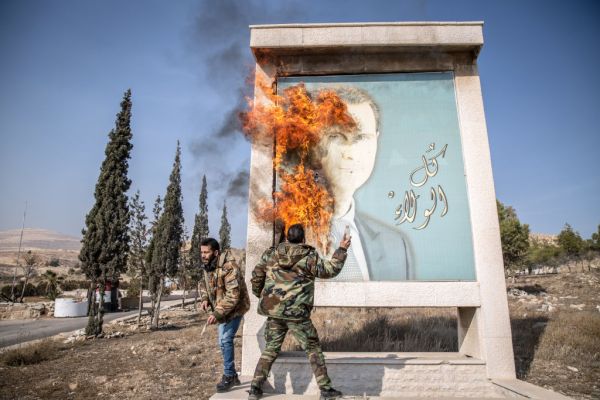In October 2019, following a call with Turkish leader Recep Tayyip Erdoğan, then-President Donald Trump ordered the withdrawal of U.S. troops from northeast Syria. Days later, Turkey launched a cross-border offensive into positions held by U.S.-allied Kurdish fighters, carving out a chunk of northern Syria, forcing the flight of more than 300,000 people, and leaving hundreds dead.
Now, in the wake of President Bashar al-Assad’s fall, Syria’s ethnic Kurds have once again found themselves distinctly vulnerable to attacks by Turkish and Turkish-backed forces.
As rebel groups consolidate power in post-Assad Syria, Turkey—which supported the two main militias spearheading the regime’s overthrow—is reportedly preparing for another large-scale incursion into Kurdish-run areas. The Biden administration has affirmed U.S. support for the Kurdish-dominated Syrian Democratic Forces (SDF), which fights alongside American troops to combat the Islamic State. But Trump’s return to the White House next month adds another layer of uncertainty about America’s future role in Syria.
The former president has long aspired to withdraw U.S. troops from the country—which he once referred to as a land of “sand and death”—and reiterated his desire to take a hands-off approach amid the government’s collapse. At a time when the Kurds are uniquely exposed, the incoming administration raises the specter of an American retreat—a decision that could spell disaster for the U.S. allies and their efforts to contain terrorist groups, opening the door to a resurgence of jihadist violence.
The U.S. began its military and financial support for rebel groups in Syria in 2013, following Assad’s use of chemical weapons against his own people. But the deployment of American troops on the ground served another purpose: degrading and preventing the resurgence of the Islamic State, a terrorist organization with global aspirations. Some 900 U.S. troops remain in the country to continue counterterrorism operations as ISIS and other extremist groups try to reconstitute.
Key to those efforts is the U.S. partnership with the SDF, which runs an enclave in eastern Syria that covers about 30 percent of the country’s territory. In addition to fighting alongside American troops to wrest cities and towns from terrorist control at the height of the civil war, the predominantly Kurdish fighters currently hold thousands of ISIS militants in detention centers across northeast Syria.
For the Syrian Kurds, reports of a looming Turkish attack together with an incoming Trump administration raise fears of a 2019 redux. When Trump ordered U.S. troops to withdraw from northeast Syria, he did so without notifying the SDF’s leadership—although the decision was later largely reversed. This time around, the president-elect could reach an agreement to end America’s military presence in Syria entirely, particularly if Ankara commits to helping the new government fight ISIS and prevent Iran from reestablishing its foothold in the country.
“For the Trump administration, the Iranian angle will be very important,” Ömer Özkizilcik, a nonresident fellow for the Atlantic Council’s Syria Project, said from Damascus. “Wherever Turkey is, Iran isn’t.”
Trump’s congenial relationship with Erdoğan, Turkey’s longtime leader, could also portend an American withdrawal from Syria. During a wide-ranging press conference Monday, the president-elect indicated that Ankara had orchestrated the Assad regime’s fall by arming the rebels leading the charge: “And that’s okay, that’s another way to fight,” he said. “Erdoğan is somebody I got along with great, but he has a major military force. And his has not been worn out with war. He’s built a very strong, powerful army.”
Trump’s comments may be laying the groundwork for a scenario in which Turkey assumes responsibility for counterterrorism operations in Syria in exchange for the end of American support to the SDF. But some analysts are unconvinced of Ankara’s willingness to counter terrorist groups like ISIS and al-Qaeda at a time when they’re likely to seek to capitalize on Syria’s political instability.
“There are risks to our counterterrorism strategy in Syria, because no one really knows the actual Turkish commitment to fighting extremists, and the record is spotty,” said Steven Cook, a Middle East expert at the Council on Foreign Relations, citing the Turkish government’s support for jihadist groups in Syria and history of providing safe haven for terrorists in Turkey.
Even before the Assad regime’s fall, U.S. Central Command observed an increase in attempts by ISIS to reconstitute this year. Attacks by the group have tripled since January, Charles Lister, a director at the Middle East Institute, reported in the New York Times. Syria’s regime change is likely to exacerbate that trend, as the SDF—the country’s strongest bulwark against the terrorist group—diverts its fighters and attention to defend against advances by Turkish-backed forces. Kurdish officials now fear the possibility of an attempted prison break to free the thousands of ISIS fighters and affiliates currently under their control.
“The SDF is occupied with fighting Turkish-backed rebels and the more they become engaged in these new fronts, the more [ISIS] will try to attack,” SDF representative Bassam Ishak told the Telegraph last week. “That increases the risk of a prison break with the help of sleeper cells.”
With Syria’s new government still taking shape, a U.S. abandonment of the SDF could also leave Kurds—who make up about 10 percent of Syria’s population of roughly 23 million—vulnerable to ethnically motivated violence. Like Syrians across the country, Kurdish leaders celebrated the fall of the Assad regime’s 30-year rule, even adopting the opposition’s flag in a sign of unity. But the rebels’ advances have already brought them into conflict with the SDF in cities and towns across the country, including Tal Rifaat and Manbij, where the Turkish-backed Syrian National Army (SNA) has seized control.

Kurdish forces are also preparing to defend against possible Turkish attacks on Kobani, a Kurdish-majority city near Turkey’s border. In a tweet Tuesday, the commander of the SDF offered to establish Kobani as a “demilitarized zone” under U.S. supervision in an apparent bid to forestall a Turkish offensive. But it’s unclear whether Ankara will be willing to leave any part of the armed Kurdish enclave intact.
American support for Kurdish forces in Syria has long been a source of tension between Washington and Ankara, which accuses the U.S. of propping up a “terror corridor” in eastern Syria through its partnership with the SDF. Erdoğan views the Syrian group as being the same as the Kurdistan Workers’ Party, armed separatists behind hundreds of terrorist attacks in Turkey, including the brief violent occupation of a state-run aerospace company headquarters in October.
Although there’s little independent evidence of Syrian Kurds’ involvement in the incidents, Turkey has long sought to push away Kurdish forces from its southern border, launching three offensives between 2016 and 2019. Now, with both of the rebel groups leading the Assaad regime’s ouster having varying degrees of Turkish backing, Ankara has emerged as the predominant regional power in post-Assad Syria.
The Turkish government hasn’t been coy about what this newfound influence means. Shortly after meeting with Secretary of State Antony Blinken last week, Turkish Foreign Minister Hakan Fidan described the “elimination” of a Kurdish militia as his country’s “strategic goal.” Turkey has long urged the U.S. to pull its troops out of Syria—a move that would, as in 2019, pave the way for a large-scale attack against Kurdish forces—and will likely do so again when Trump takes office next month.
But Trump’s advisers may yet talk him out of a full U.S. withdrawal from Syria amid the country’s delicate security situation, as they appeared to do during his first term. The president-elect’s nominee for secretary of state, Sen. Marco Rubio, has long been a vocal supporter of partnering with Kurds in Syria. After the 2019 incident, Rubio accused the Trump administration of abandoning the Kurds to “face annihilation at the hands of the Turkish military.” Rep. Mike Waltz, whom Trump has selected as his national security adviser, likewise called on Washington to stand with its Kurdish allies amid the Turkish invasion.
Now, with a new government in Damascus, it’s unclear where the Kurds fit in. Ahmed al-Sharaa, formerly known as Abu Mohammed al-Jolani—the leader of Hayat Tahrir al-Sham (HTS), the rebel group primarily responsible for ousting Assad—has sought to strike a conciliatory tone, urging his fighters to respect minority rights and describing the Kurds as an “integral part” of Syrian society. But he’s also unlikely to tolerate the semi-autonomy of another armed group within Syria’s borders, particularly if Turkey has a say in it.
The HTS has “a very clear jihadist vision of imposing a type of Islamic rule on Syria. I don’t see how they could accommodate a group like the SDF without making it into something subordinate. The group’s goal, ultimately, is to take over all of Syria,” Ido Levy, an analyst with the Washington Institute and author of a book on the Islamic State, told The Dispatch. “If Trump were to withdraw, it could be a disaster for the SDF. It could be bad for the fight against ISIS, too.”
For Kurdish civilians, too, the end of U.S. involvement in Syria could prove catastrophic. Turkey and its armed proxies in Syria have a long record of human rights abuses against Kurdish communities on both sides of the border. But analysts fear Erdoğan’s threatened advances may leave the U.S. with few good options, particularly when faced with the possibility of two NATO allies pitted against one another.
“I think when push comes to shove,” Cook said, “we’ll shove the Kurds in favor of Turkey.”







Please note that we at The Dispatch hold ourselves, our work, and our commenters to a higher standard than other places on the internet. We welcome comments that foster genuine debate or discussion—including comments critical of us or our work—but responses that include ad hominem attacks on fellow Dispatch members or are intended to stoke fear and anger may be moderated.
With your membership, you only have the ability to comment on The Morning Dispatch articles. Consider upgrading to join the conversation everywhere.